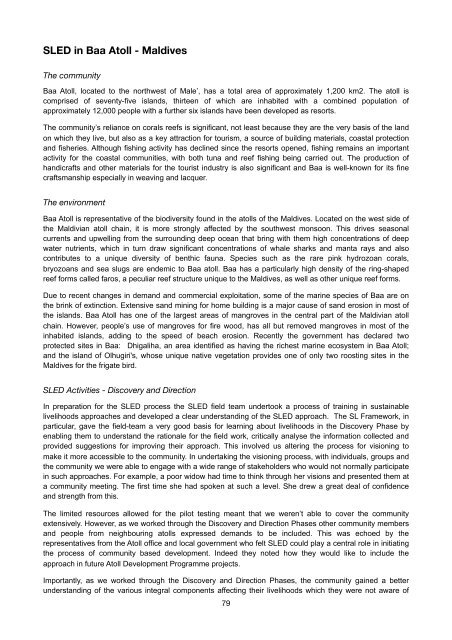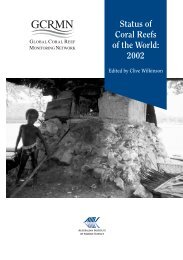Sustainable Livelihoods Enhancement and Diversification (SLED)
Sustainable Livelihoods Enhancement and Diversification (SLED)
Sustainable Livelihoods Enhancement and Diversification (SLED)
You also want an ePaper? Increase the reach of your titles
YUMPU automatically turns print PDFs into web optimized ePapers that Google loves.
<strong>SLED</strong> in Baa Atoll - Maldives<br />
The community<br />
Baa Atoll, located to the northwest of Male’, has a total area of approximately 1,200 km2. The atoll is<br />
comprised of seventy-five isl<strong>and</strong>s, thirteen of which are inhabited with a combined population of<br />
approximately 12,000 people with a further six isl<strong>and</strong>s have been developed as resorts.<br />
The community’s reliance on corals reefs is significant, not least because they are the very basis of the l<strong>and</strong><br />
on which they live, but also as a key attraction for tourism, a source of building materials, coastal protection<br />
<strong>and</strong> fisheries. Although fishing activity has declined since the resorts opened, fishing remains an important<br />
activity for the coastal communities, with both tuna <strong>and</strong> reef fishing being carried out. The production of<br />
h<strong>and</strong>icrafts <strong>and</strong> other materials for the tourist industry is also significant <strong>and</strong> Baa is well-known for its fine<br />
craftsmanship especially in weaving <strong>and</strong> lacquer.<br />
The environment<br />
Baa Atoll is representative of the biodiversity found in the atolls of the Maldives. Located on the west side of<br />
the Maldivian atoll chain, it is more strongly affected by the southwest monsoon. This drives seasonal<br />
currents <strong>and</strong> upwelling from the surrounding deep ocean that bring with them high concentrations of deep<br />
water nutrients, which in turn draw significant concentrations of whale sharks <strong>and</strong> manta rays <strong>and</strong> also<br />
contributes to a unique diversity of benthic fauna. Species such as the rare pink hydrozoan corals,<br />
bryozoans <strong>and</strong> sea slugs are endemic to Baa atoll. Baa has a particularly high density of the ring-shaped<br />
reef forms called faros, a peculiar reef structure unique to the Maldives, as well as other unique reef forms.<br />
Due to recent changes in dem<strong>and</strong> <strong>and</strong> commercial exploitation, some of the marine species of Baa are on<br />
the brink of extinction. Extensive s<strong>and</strong> mining for home building is a major cause of s<strong>and</strong> erosion in most of<br />
the isl<strong>and</strong>s. Baa Atoll has one of the largest areas of mangroves in the central part of the Maldivian atoll<br />
chain. However, people’s use of mangroves for fire wood, has all but removed mangroves in most of the<br />
inhabited isl<strong>and</strong>s, adding to the speed of beach erosion. Recently the government has declared two<br />
protected sites in Baa: Dhigaliha, an area identified as having the richest marine ecosystem in Baa Atoll;<br />
<strong>and</strong> the isl<strong>and</strong> of Olhugiri's, whose unique native vegetation provides one of only two roosting sites in the<br />
Maldives for the frigate bird.<br />
<strong>SLED</strong> Activities - Discovery <strong>and</strong> Direction<br />
In preparation for the <strong>SLED</strong> process the <strong>SLED</strong> field team undertook a process of training in sustainable<br />
livelihoods approaches <strong>and</strong> developed a clear underst<strong>and</strong>ing of the <strong>SLED</strong> approach. The SL Framework, in<br />
particular, gave the field-team a very good basis for learning about livelihoods in the Discovery Phase by<br />
enabling them to underst<strong>and</strong> the rationale for the field work, critically analyse the information collected <strong>and</strong><br />
provided suggestions for improving their approach. This involved us altering the process for visioning to<br />
make it more accessible to the community. In undertaking the visioning process, with individuals, groups <strong>and</strong><br />
the community we were able to engage with a wide range of stakeholders who would not normally participate<br />
in such approaches. For example, a poor widow had time to think through her visions <strong>and</strong> presented them at<br />
a community meeting. The first time she had spoken at such a level. She drew a great deal of confidence<br />
<strong>and</strong> strength from this.<br />
The limited resources allowed for the pilot testing meant that we weren’t able to cover the community<br />
extensively. However, as we worked through the Discovery <strong>and</strong> Direction Phases other community members<br />
<strong>and</strong> people from neighbouring atolls expressed dem<strong>and</strong>s to be included. This was echoed by the<br />
representatives from the Atoll office <strong>and</strong> local government who felt <strong>SLED</strong> could play a central role in initiating<br />
the process of community based development. Indeed they noted how they would like to include the<br />
approach in future Atoll Development Programme projects.<br />
Importantly, as we worked through the Discovery <strong>and</strong> Direction Phases, the community gained a better<br />
underst<strong>and</strong>ing of the various integral components affecting their livelihoods which they were not aware of<br />
79
















